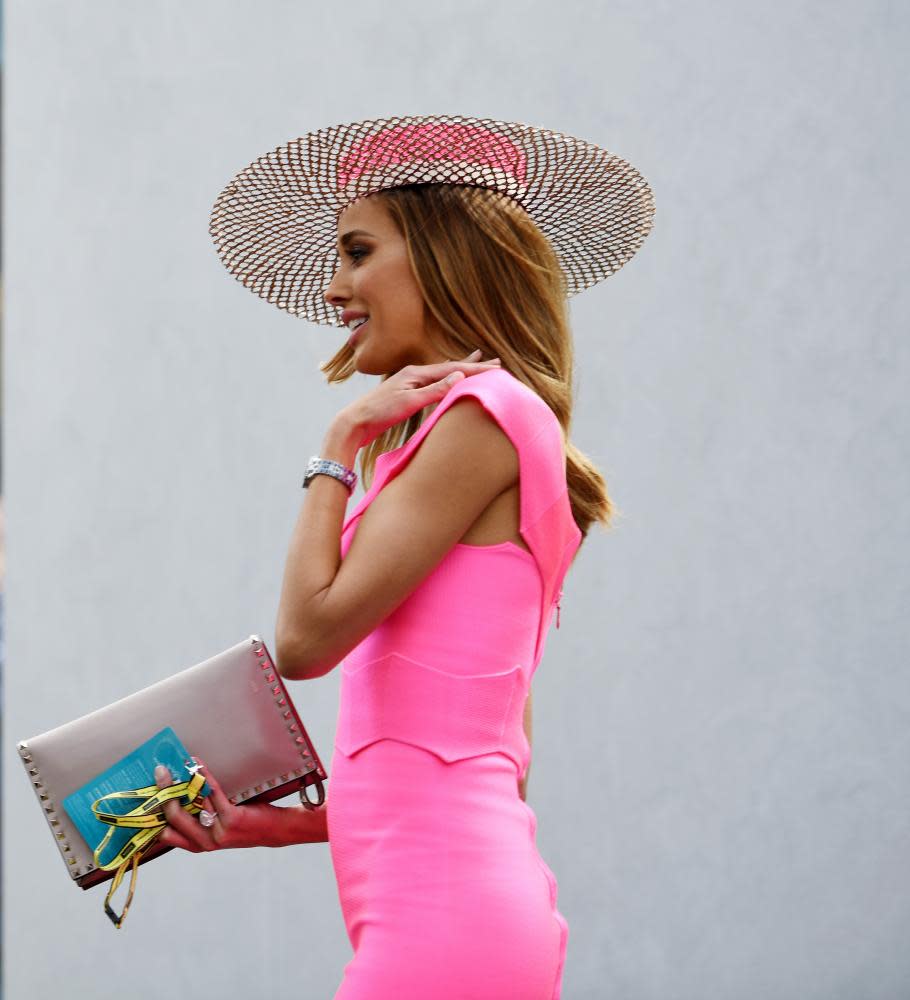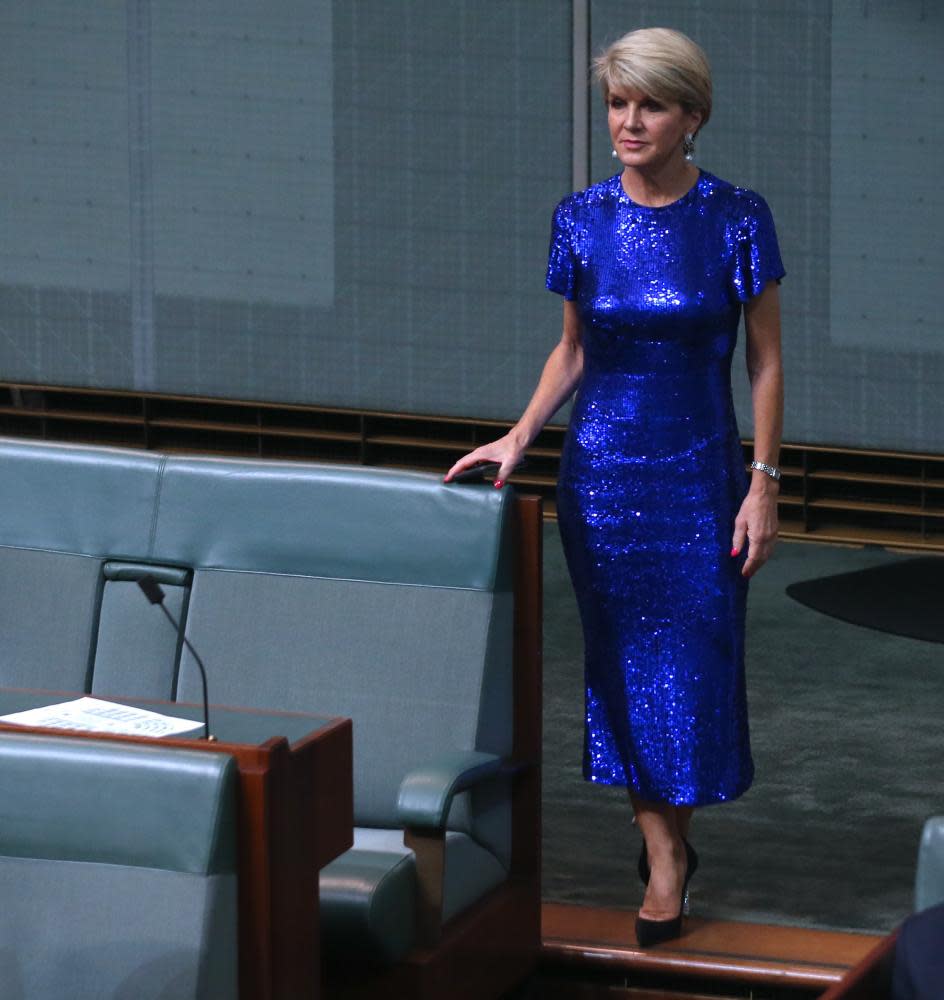Byron babes and hype marsupials: the 10 most influential looks of the decade
In the 2010s, Australian fashion had its own subcultures, each with favoured designers and brands. There was some overlap – those that go to the races are known to vacation in Positano – but for many Australians, getting dressed is as much about personal identity as specific trends. While some were influenced by fashion globally, other looks were purely homegrown.
Ladies who Lycra

The active wear market boomed this decade as yoga and fitness studios popped up faster than you could say “namaste”. It was no wonder Australians embraced the Lycra-led movement with particular zeal, given our love of sport, beaches and the great outdoors. With PE Nation by Pip Edwards, Stylerunner, The Upside and First Base among the local fashionable fitness brands that entered the (sporting) arena, working out became as much about dressing in designer duds as it did about deadlifts or downward dogs.
“I was so uninspired by what was out there because I wanted something new and trend-setting to wear when I was doing Bikram yoga,” says Stylerunner founder Julie Stevanja. “I knew the opportunity was huge because if I wanted this activewear there must be other women out there who felt the same way.”
She was right.
Show ponies

Some may have started saying #nuptothecup, but bright colours, short skirts and sharp tailoring – like Aeroguard and Golden Gaytimes – are a perennial at the Melbourne Cup Carnival. Championed by Melbourne racing style royalty including Rebecca Judd, Jesinta Franklin and Jennifer Hawkins, the peplums, bold prints and fascinators that make up Australian race wear proved they have more staying power than Black Caviar, dominating the front pages of tabloid newspapers across the country as well as the racks of Myer and David Jones year after year.
Diplomatic dressers

When Julie Bishop was named by Tony Abbott as foreign affairs minister in 2013, she appointed herself an unofficial ambassador for Australian designers, wearing their creations frequently while overseas at glittering events. She earned herself the nickname “Minister for Fashion” and soon enough she sort of became one, after helping Vogue Australia editor in chief Edwina McCann found the Australian Fashion Council. Bishop, who often used the hashtag “fashion diplomacy” in her social media posts, formalised the relationship between the Department of Foreign Affairs and Trade (DFAT) and the industry body in a memorandum of understanding in 2015. Regardless of what you think of her policies, her signature tailored corporate chic provided an inspiration to women workers across Australia, with a wardrobe featuring everything from power shoulders and pant suits to sequins and evening gowns.
Gentrified surfers

Who knew the Hawaiian shirt would have a reboot via Bondi? Double Rainbouu’s colourful, print-driven designs became the go-to for Aussie festival dudes and surfer gents after Mikey Nolan and Toby Jones came up with the idea of reinventing the holiday staple while taking a break in Thailand.
“We saw a gap in the market for doing Hawaiian shirts in a fresh, contemporary way,” says Nolan. “Beachwear makes sense coming from Australia and people in the international market look to us for print and colour.”
Related: The fashion quiz of the year: from J-Lo's astonishing runway look to The Dress
The vacay vibe continued with brands such as Holiday the Label, which produced pastel puff paint T-shirts, caps and swimmers featuring slogans like “Beach Bum”, “Holiday” and “Lifestyles of the Bored and Aimless”. High end menswear brand Commas also dished up some seriously luxe Hawaiian shirts and boardies, and even surf wear stalwart Rip Curl got in on the wave of Splices, sunscreen and sandy toes with its $350m sale to Kathmandu in October.
Byron babes
Forget the big cities – by 2019 Australia’s new fashion capital had firmly cemented itself. This decade Byron Bay emerged as the epicentre for the boho chic look that has dominated our beaches and bars, championed by local labels such as Arnhem, The Goddess of Babylon, Amalita and The Freedom State. The queens of the hippy look that brought Byron’s relaxed dressing and free-spirited existence to the masses were sisters Isabella Pennefather and Elizabeth Abegg of Spell & The Gypsy Collective. The duo began at Byron’s local markets in 2009 with crochet dresses, fringing and festival-ready fashion and, over the past 10 years, their garments have made their way into some of the world’s top stores (Shopbop, Urban Outfitters, Free People) and into the closets of women across Australia who wanted to live the nomadic Kombi, yoga and kombucha dream – even while residing in the big smoke.
Club Med
From June to August you’re either the person enduring the Australian winter, scrolling through the Instagram feeds of friends and influencers sipping spritzes in Positano, or you are that smug person, documenting your Euro odyssey with carefully curated snaps.
The European holiday season became synonymous with the outfit choices of Australian socialites such as Nicky Oatley and Deborah Symond, and back at home over summer you couldn’t get far in Bondi or St Kilda without seeing Lucy Folk’s sunglasses strung on a cord, shortie linen dresses by Alex and Trahanas or Matteau’s liberty-print tiered sundresses. They are all shown off on Instagram, inspiring a boom in resort and destination dressing.
“Ten years ago if you went on holiday to a tropical island it was always cut-off denim shorts and a tank, but now thanks to Instagram people are meticulously planning fashion outfits for social media,” says Lindy Rama-Ellis, who has the resort brand Rama Voyage.
Licensed and deadly
In 2012, US fashion darlings Rodarte found themselves in hot water over the use of prints from the estate of Benny Tjangala. Although the works were reproduced under license, Rodarte never credited the Pintupi artist. Since that misstep, plenty of labels subsequently have given credit and cash where it is due.
The rise of digital printing has made it easier to bring complex artwork to life on clothing, at a more affordable price. A number of brands, both Indigenous and non-Indigenous owned, have employed this technology to showcase First Nations Australian art on garments. Rebooted in 2013, 80s favourite Desert Designs features the artwork of Jimmy Pike, while BRACKS celebrates Torres Strait, South Sea Islander and Aboriginal cultures through their best-selling polo shirts for men.
Shannon Brett, a descendant of the Wakka Wakka, Budjula and Gurang Gurang clans, founded her label Lore with a vision to work with art centres across the country. She showed at London Pacific Fashion Week in 2018. The same year, Lyn-Al Young partnered with David Jones on a NAIDOC week fashion collection, and in 2019 Melbourne brand Gorman partnered with the WA-based Mangkaja Arts Resource Agency to produce a capsule collection featuring the prints of five artists – Ngarralja Tommy May, Sonia Kurarra, Daisy Japulija, Nada Tigila Rawlins and Lisa Uhl – which the Australian Copyright Agency described as “a benchmark for future fashion licensing agreements”.
Hype marsupials
As Off-White, Vetements and Supreme led the global rise of streetwear, Australia entered the hypebeast fray, with local brands creating cult caps, hoodies, kicks and even skateboards.
At the pointy end of the market Song for the Mute and Chronicles of Never emerged for Style Zeitgeist-types, manufacturing their moody garments almost entirely in black. The unisex label Cocurata launched in 2015, founded by Ksubi alumni George Gorrow and New York-based gallerist George Benias, to exist somewhere between an art project and a fashion house.
Feit made “neo luxury” hand-crafted leather trainers for men and women and now has stores in Sydney and New York. The brand was founded by brothers Josh and Tull Price, who created cult London-based sneaker brand Royal Elastics in 1996, then sold it in 2012.
Related: What were we thinking? The worst trends of the decade – ranked!
“I’d become disenfranchised with the idea of design and marketing being driven purely by the requirement for increased volume, so the name Feit was about fighting that system of doing business and trying to find a way to go back to focusing purely on product and quality,” says Tull Price.
At a more affordable price point you could shop the trippy graphics of Melbourne brand Perks and Mini or the technical garb of Kloke, which hails from the same city. Perth-based Butter Goods specialises in skatewear, while Penny Skateboards create the actual boards, a new take on the classic longboard in plastic rather than plywood.
Carbon neutrals
A post shared by bassike (@bassike) on Nov 22, 2019 at 3:15pm PST
Organic, vegan, slow-fashion and ethical. While many words have been bandied about to describe the shift to more conscious fashion choices over the past 10 years, what sustainable style actually looked like was much easier to pinpoint. It was neutral and basic. Earth tones, minimalism, white T-shirts and shift dresses dominated the feeds of ethical fashion fans, not just because it was easier to produce sustainable clothing in neutral tones without, say, sequins or vinyl, but also out of practicality. It’s far easier to live with less when everything you own matches.
This is slowly changing. As we moved through the decade, brands began shifting the thinking around what sustainable clothing could be, injecting vibrants prints, embellishments and trims into everything from cocktail and wedding dresses to denim and swimwear.
Kit X, Kowtow and Bassike were among the Australian brands who led the way to more, well – fashionable – ethical fashion, a trend that will only continue to grow into the future. “KitX is not a hippy hemp brand; it’s sensual, design-oriented fashion that people want to wear,” says KitX founder Kit Willow.
Australiana endures
When Romance Was Born re-released its May Gibbs print shorts, caps and shirts in late 2019, they sold out almost immediately. The Sydney brand has been obsessed with our national icons since it was founded 15 years ago, and continues to ride a renewed wave of interest in Australiana with a fresh collection of gum nut, kangaroo and wattle dusted garments following its 2018 fashion show during haute couture in Paris, which featured a cockatoo bride, a kimono made from souvenir tea towels and a new take on Jenny Kee’s koala jumper.
“Australiana was once taken in a negative context, but I like to think of it now as exotica because I feel like Australians are becoming a lot more curious about their culture,” says RWB co-founder Luke Sales.
A veritable B&S ball of the label’s back catalogue was also worn by guests at the opening of Jenny Kee and Linda Jackson: Step Into Paradise at the Powerhouse Museum in November. The retrospective spanning more than four decades of the duo’s partnership mining Australian influences and inspiration, put another spotlight on the way our fashion can reflect our cultural influences and celebrate our identity.


